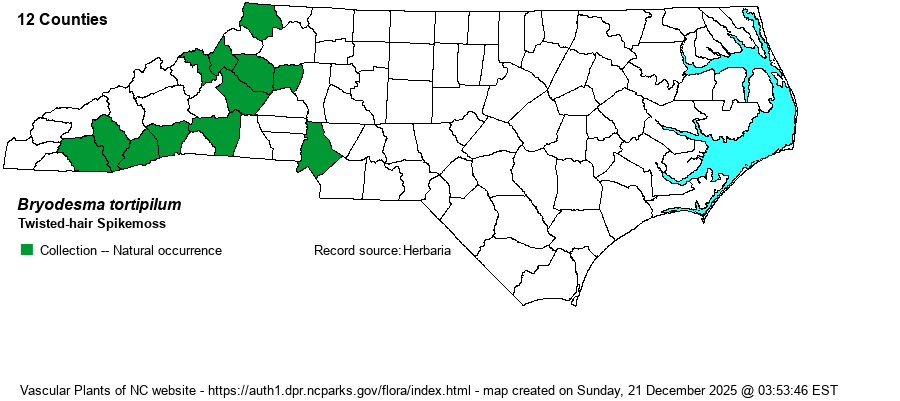| Section 1 » Family Selaginellaceae |
Show/Hide Synonym
| taxonName | relationship | relatedTaxonName | relatedTaxonRefText | relComments |
|---|
| Bryodesma tortipilum | = | Selaginella tortipila | Flora of North America (1993b, 1997, 2000, 2002a, 2002b, 2003a, 2004b, 2005, 2006a, 2006b, 2006c, 2007a, 2009, 2010) | | | Bryodesma tortipilum | = | Selaginella tortipila | Kartesz (1999) | | | Bryodesma tortipilum | = | Selaginella tortipila | Radford, Ahles, and Bell (1968) | | | Bryodesma tortipilum | = | Selaginella tortipila | Small (1933, 1938) | | | Bryodesma tortipilum | = | Selaginella tortipila | Wofford (1989) | | | Source: Weakley's Flora |
|
| Author | (A. Braun) Sojak | |
| Distribution | Scattered across much of the Mountains, very rarely to the south-central Piedmont (Mecklenburg County).
This is a Southern Appalachian and Piedmont endemic, with a small range. It occurs only from northwestern NC to east-central GA.
| |
| Abundance | Infrequent to locally fairly common along the Blue Ridge Escarpment, but quite rare farther west of this region (i.e., toward the TN line). Very rare in the western half of the Piedmont. | |
| Habitat | This is a rock outcrop species, usually at middle and high elevations, mainly over 2500 feet. Unlike with B. rupestre, this species often grows in crags and crevices of cliffs and on rocky summits, on granite and other felsic rocks. B. rupestre grows mainly on domes and flatrocks, on mostly horizontal surfaces. |
| Phenology | Fruits from July to September. | |
| Identification | This is a moss-like species, with a long stem and numerous branches, often reaching 8-9 inches long, with a gray-green appearance. The ends of the branches are usually strongly upturned and erect, reaching 3-4 inches high. The branches are covered in densely packed scale-like leaves with pointed tips. The strobilus in this species is quite short, only about 1/5-inch long. As the common and scientific names imply, the tips of the leaves are twisted or contorted, as opposed to straight in the other two NC Bryodesma species. The species can perhaps grow on the same mountain or rocks as with B. rupestre, but that species has mostly dark green leaves, tends to grow more prostrate and thus with a shorter look, and its sites are mostly on domes and flatrocks. | |
| Taxonomic Comments | Most references named this species, and some still do, as Selaginella tortipila.
| |
| Other Common Name(s) | None | |
| State Rank | S3 | |
| Global Rank | G3 | |
| State Status | | |
| US Status | | |
| USACE-agcp | | |
| USACE-emp | | |

